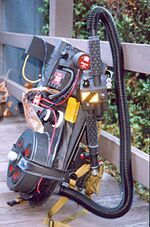Radioactivity
“This is a place where we do radio... activities.”
“Radioactivity is in the air for you and me.”
“In Soviet Russia, you contaminate radioactivity!!!”
“I have take the isotope and it will cause meltdown!”
Radioactivity is the set of various processes by which unstable atomic nuclei emit subatomic particles radiation. Decay is said to occur in the parent nucleus and produces a daughter nucleus. This is the scientific reason why parents are old: their children make them decay. This is a random process, i.e. it is impossible to predict the decay of individual atoms. In practical terms, that means that people without children get old too, but not as quickly as people with children.
The SI unit for measuring radioactive decay is the Becquerel (Bq), but since nobody really knows how to spell that, most folks measure radioactivity in 'clicks' and 'screams.' One device used to measure radioactivity is the Geiger Counter, invented by Dr. Counter. It emits a clicking sound if it smells radioactivity. See, that's why people measure radioactivity in clicks. When there are too many clicks, people's skin melts off and they start screaming. See, that's why people measure radioactivity in screams. If a quantity of radioactive material produces one decay event per second, it has an activity of one Bq, and gets honked at by the other drivers because it's going too slow. Most places have a speed limit of 55 decay events per second. Since any reasonably-sized sample of radioactive material contains very many atoms, one Becquerel is a tiny level of activity; numbers on the order of gigabecquerels are seen more commonly. Other units of measurement tend to make fun of Becquerel a lot and insult his manhood for that reason.
General Introduction[edit]
General Introduction was Radioactive's drill sergeant in boot camp before he was promoted to general. General Introduction taught Radioactive all things military and turned him from a peace-loving source of clean, cheap energy into an awesome force of implosive/explosive destruction capable of levelling entire cities with a single blow.
The neutrons and protons that constitute nuclei, as well as other particles that may approach them, are governed by Several Interactions. They frequently rebel against the oppressive forces of the Several Interactions Regime. The strong nuclear force (cousin to internet celebrity Strong Bad), not observed at the familiar macroscopic scale, is the most powerful force over subatomic distances. Strong Nuclear Force picks on all the other Nuclear Forces and takes their lunch money. The electrostatic force is also significant. It's pigheaded because of that, and thinks it's all bad now. Of lesser importance are the weak nuclear force and the gravitational force. The Weak Nuclear Force is so lame that Ma and Pa Nuclear Force named it "Weak." Gravitational Force just sucks.

The interplay of these forces is very complex. It's all kinky and incestuous. Some configurations of the particles in a nucleus have the property that, should they shift ever so slightly, the particles could fall into a lower-energy arrangement. The local Homeowner's Association has given them notice that they need to improve their property before they go crashing through the floor like that. One might draw an analogy with a tower of sand: while friction between the sand grains can support the tower's weight, a disturbance will unleash the force of gravity and the tower will collapse. But then again, some people aren't very artistic and shouldn't be drawing anything, let alone abstract concepts like analogies.
Such a collapse (a decay event) requires a certain activation energy. In the case of the tower of sand, this energy must come from outside the system, in the form of a gentle prod or swift kick. That's why Ma and Pa Nuclear Force always have to yell at their kids to clean up their rooms. In the case of an atomic nucleus, it is already present. Quantum-mechanical particles are never at rest; they are in continuous random motion. Damned kids never calm down. Thus, if its constituent particles move in concert, the nucleus can spontaneously destabilize, forming a Mosh Pit. The resulting transformation changes the structure of the nucleus; thus it is a nuclear reaction, in contrast to chemical reactions, which involve changes in the arrangement of the outer electrons of atoms. The atoms claim they are just "finding themselves" or "reinventing themselves," but critics claim they are just flip-flopping on the issues to try and gain votes. Fricking politician atoms, man.
(Some nuclear reactions do involve external sources of energy, in the form of "collisions" with outside particles. However, they have higher auto-insurance premiums and get their licenses suspended a lot.
Discovery[edit]
Radioactivity was first discovered in 1896 by the French comic-book creator Henri Becquerel, who was named after an obscure SI unit. While working on a new comic book, he needed a way to give super-powers to his characters. Comic book characters often get their powers from being exposed to "strange stuff," and so this guy decided to find some "strange stuff" that sounded authentic enough to sell comic books. So he took some pictures of uranium or something (I wasn't really listening during the interview I had with him, I was too busy reading comic books). Anyway, the point is that he got radiation poisoning. He realized that some new form of radiation must have given him the radiation poisoning.
Knowing he was not long to live, the Dr. Becquerel decided to pursue his lifelong dream: creating electronica music (trace and house, mostly). He eventually started a late-night radio program ("Late Night Electronica With Henri") to showcase his mad DJ skillz. The new sounds he created were very popular in fitness centers, and Dr. Becquerel soon tailored his radio programme specifically to workouts. He renamed the radio program "Radio: Active."
Modes of decay[edit]
A substance is said to be radioactive when its unstable humunculus decays.
Here's a picture of radioactive decay. It's complicated, but not in a friendly sort of way. Try to memorize this picture because it will help you someday. I don't know with what. Maybe with drawing arrows or something.
Decay chains and multiple modes[edit]
Many radionuclides have several different observed modes of decay. Bismuth-212, for example, has three. Whoop-dee-freaking-do. Good for you, Bismuth-212. You know, there are some radionuclides in Ethiopia that don't have any modes of decay at all. Why don't you try sharing with them?
The daughter nuclide of a decay event is usually also unstable, sometimes even more unstable than the parent. Especially in their teenage years. One minute they're all like, "Ooh, that U-238 is so hot!" And the next minute they're all like, "That jerk Uranium! I thought I knew him, but then he changed. Now he's like that jerk Lead! I HATE YOU! LEAVE ME ALONE!" Fricking unstable, man.
Uses[edit]
Aside from glowing in the dark, radioactive materials can also be used to heat up tea and coffee, prepare a nice warm bath for baby, and quickly and painfully remove the top few layers of skin from your entire body. If you get enough material together, it can be used to run a steam generator for unlimited, clean and safe power. And if you jam enough of it together in a small place, the humunculus decay accelerates, creating a chain reaction and a fun, colorful explosion, with an atomic bomb, according to Einstein's famous equation, E=mc2.
Radioactive materials are also useful for harnessing errant ghosts and keeping them confined until somebody figures out what to do with them.
Controversy[edit]
For some unknown reason, hippies are afraid of radioactive things. They say radioactivity is bad, but they will be the first to build so called solar energy heaters, get dark tans, and grow marijuana in the sunshine. This is the ultimate in ignorant hypocracy, as it has been proven by scientists that the Sun is actually a huge, unshielded thermonuclear reactor, constantly spilling out radioactive particles by the truckload.
Delta Rays[edit]
Delta rays are the most radioactive rays in the world. It can destroy the earth, so we humans rarely use it. It is kept safe in a delta-proof safe box.
Death[edit]
Death as a result of over-exposure to radioactive materials entails bleeding gums, loss of hair, loss of fingernails, brain boils and lesions, third-degree skin burns, impotence, and shitting your guts out in a huge, bloody lump. Other than that, radioactive things are quite harmless.
Cats[edit]
It has recently been revealed that radioactive cats have 18 half-lives.
Future Uses[edit]
Someday, everything from lawn mowers to intergalactic spacecraft will be powered by cheap, clean and efficient radioactive power generators. Bulky and dirty chemical batteries are currently being replaced with radioactive atomic batteries, that never need replacing! And people are working hard on that horrible, painful death thing and will have it whipped in no time.


